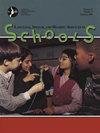The Perceived Value of Interprofessional Practice According to Classroom Teachers, Special Education Teachers, and Speech-Language Pathologists.
IF 2.9
3区 医学
Q1 AUDIOLOGY & SPEECH-LANGUAGE PATHOLOGY
Language Speech and Hearing Services in Schools
Pub Date : 2025-08-08
DOI:10.1044/2025_lshss-24-00154
引用次数: 0
Abstract
PURPOSE When working with students with speech, language, and communication needs, classroom teachers (CLTs), special education teachers (SETs), and speech-language pathologists (SLPs) must engage in interprofessional practice (IPP). According to the expectancy-value model, IPP adoption is partially contingent on its perceived value. The objective of this study was to analyze whether and how the perceived value of IPP differs across four domains (interest, costs, benefits for the specialist, and benefits for the students) among the three professional groups and the extent to which various factors affect this perception. This study focuses on school-based professionals in the Canton of Bern, Switzerland, working under the same administrative authority and in accordance with the same guidelines. METHOD A total of 317 staff members from mainstream schools in Bern, Switzerland (142 CLTs, 89 SETs, and 86 SLPs), completed an IPP questionnaire. Confirmatory factor analysis was used to compare the four domains of perceived values between groups, and structural equation modeling was used to assess the impact of various factors. RESULTS SETs showed the most positive perception of IPP across all domains, whereas CLTs and SLPs were less positive. Self-reported competencies in IPP positively influenced the perceived value of CLTs and SLPs; however, perceptions were more negative at the secondary school level for CLTs and SLPs. CONCLUSION Since CLTs, SETs, and SLPs in the Canton of Bern, Switzerland, operate under the same administrative guidelines, the differences in perceived value of IPP are attributed to their distinct professional backgrounds and work environments. SUPPLEMENTAL MATERIAL https://doi.org/10.23641/asha.29637284.课堂教师、特殊教育教师和语言病理学家对跨专业实践的感知价值。
目的:课堂教师(clt)、特殊教育教师(set)和言语语言病理学家(slp)在与有言语、语言和交流需求的学生打交道时,必须进行跨专业实践(IPP)。根据期望值模型,IPP的采用部分取决于其感知价值。本研究的目的是分析在三个专业群体中,IPP的感知价值是否以及如何在四个领域(兴趣、成本、专家的利益和学生的利益)有所不同,以及各种因素影响这种感知的程度。本研究的重点是瑞士伯尔尼州的校本专业人员,他们在相同的行政当局下按照相同的指导方针工作。方法:来自瑞士伯尔尼主流学校的317名教师(142名clt, 89名SETs和86名slp)完成了IPP问卷调查。采用验证性因子分析比较各组间感知值的四个域,采用结构方程模型评估各因素的影响。结果set在所有领域中表现出最积极的IPP感知,而clt和slp则不那么积极。IPP自我报告能力正向影响clt和slp的感知价值;然而,在中学阶段,对clt和slp的看法更为消极。结论:由于瑞士伯尔尼州的clt、SETs和slp在相同的行政指导下运作,IPP的感知价值差异归因于他们不同的专业背景和工作环境。补充MATERIALhttps: / / doi.org/10.23641/asha.29637284。
本文章由计算机程序翻译,如有差异,请以英文原文为准。
求助全文
约1分钟内获得全文
求助全文
来源期刊

Language Speech and Hearing Services in Schools
Social Sciences-Linguistics and Language
CiteScore
4.40
自引率
12.50%
发文量
165
期刊介绍:
Mission: LSHSS publishes peer-reviewed research and other scholarly articles pertaining to the practice of audiology and speech-language pathology in the schools, focusing on children and adolescents. The journal is an international outlet for clinical research and is designed to promote development and analysis of approaches concerning the delivery of services to the school-aged population. LSHSS seeks to advance evidence-based practice by disseminating the results of new studies as well as providing a forum for critical reviews and meta-analyses of previously published work.
Scope: The broad field of audiology and speech-language pathology as practiced in schools, including aural rehabilitation; augmentative and alternative communication; childhood apraxia of speech; classroom acoustics; cognitive impairment; craniofacial disorders; fluency disorders; hearing-assistive technology; language disorders; literacy disorders including reading, writing, and spelling; motor speech disorders; speech sound disorders; swallowing, dysphagia, and feeding disorders; voice disorders.
 求助内容:
求助内容: 应助结果提醒方式:
应助结果提醒方式:


